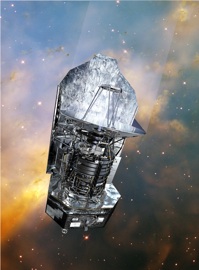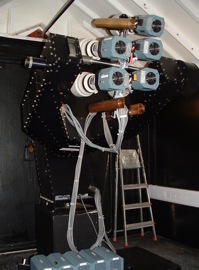|

Top Stories

|

|
 |
 |
 

Gravitational lensing weighs 70 galaxies
...the largest ever single collection of gravitational lens galaxies has helped settle a long-standing debate over the relationship between mass and luminosity in galaxies, as well as infer the presence of dark matter...
read more

Organic cemeteries could dominate ancient Mars
...two complementary studies support the popular theory that the Red Planet once hosted vast lakes, flowing rivers and a variety of other wet environments that had the potential to support life...
read more

XMM detects nova everyone else missed
...it was one of the brightest nova events of the decade and clearly visible to the naked eye, yet no one but the XMM-Newton space telescope was there for the party...
read more

|
 |
 |

|
Spaceflight Now +

|

|
 |
 |

Subscribe to Spaceflight Now Plus for access to our extensive video collections!
 How do I sign up? How do I sign up?
 Video archive Video archive

STS-120 day 2 highlights

Flight Day 2 of Discovery's mission focused on heat shield inspections. This movie shows the day's highlights.

 Play Play

STS-120 day 1 highlights

The highlights from shuttle Discovery's launch day are packaged into this movie.

 Play Play

STS-118: Highlights

The STS-118 crew, including Barbara Morgan, narrates its mission highlights film and answers questions in this post-flight presentation.

 Full presentation Full presentation
 Mission film Mission film

STS-120: Rollout to pad

Space shuttle Discovery rolls out of the Vehicle Assembly Building and travels to launch pad 39A for its STS-120 mission.

 Play Play

Dawn leaves Earth

NASA's Dawn space probe launches aboard a Delta 2-Heavy rocket from Cape Canaveral to explore two worlds in the asteroid belt.

 Full coverage Full coverage

Dawn: Launch preview

These briefings preview the launch and science objectives of NASA's Dawn asteroid orbiter.

 Launch | Science Launch | Science

 Become a subscriber Become a subscriber
 More video More video

|
 |
 |

|
|
 |

The SUPA search for extraterrestrial worlds
BY DR EMILY BALDWIN
ASTRONOMY NOW
Posted: July 23, 2008
Combining efforts and resources, researchers in the Scottish Universities Physics Alliance (SUPA) have emerged near the top of the international league when it comes to studying the possibility of life elsewhere in the Universe.

Artist impression of OGLE-2005-BLG-390Lb, an icy-rocky planet about five times the mass of the Earth, orbiting a dim star. The discovery was assisted by researchers from the University of St Andrews. Image:NASA, ESA and G. Bacon (STScI).
In the last 15 years the number of planets known outside our Solar System has risen from zero to over 300, with each new discovery adding another piece to the jigsaw puzzle of planetary formation, bringing us closer to discovering just how common life is – be it intelligent life or otherwise – in our Universe. Scottish Universities intend to play a major role in the pursuit for extraterrestrial intelligence, as demonstrated by the University of St Andrew’s award to host this year’s ‘Cool Stars, Stellar Systems, and the Sun’ conference, the first time this meeting has ever been held in the UK.
"Ultimately, we would like to understand how planet Earth works and how our civilisation came into being,” says Dr Jane Greaves, co-ordinator of the SUPA Astrobiology Initiative. “It is however the study of other worlds that holds the key for gaining insight into our own."
The SUPA researchers, who come from the University of Edinburgh, the University of Glasgow, Heriot Watt University, the University of St Andrews, the University of Strathclyde and the University of the West of Scotland, have used some of the world’s cutting-edge instruments for their groundbreaking research, including NASA's Spitzer satellite, ESA's Herschel satellite, the Japanese AKARI satellite, the James Clerk Maxwell Telescope on Hawaii, the Nobeyama Radio Observatory and the Institut de Radioastronomie Millimetrique. They also play leading roles in one of the most successful existing ground-based planet hunting programmes to date, SuperWASP, which announced a staggering ten new exoplanets in just one press release during the National Astronomy Meeting in April this year (a special report can be found here).
 
SUPA researchers have access to many world-class planet-hunting facilities, including the Herschel satellite (left) and SuperWASP (right). Image: Herschel: ESA (Image by AOES Medialab), background: Hubble Space Telescope, NASA/ ESA/ STScI; SuperWASP: the SuperWASP consortium.
SUPA researchers are also pioneering automated robotic searches using the technique of gravitational microlensing, a method that lends itself to the detection of Earth mass planets in particular.
"The detection of planets by gravitational microlensing means that we are waiting for a short blip in the light of an observed star that results from the gravitational bending by the planet and its host star which intervene the line of sight" says Dr Martin Dominik, Royal Society University Research Fellow at the University of St Andrews. “Gravitational microlensing is a promising approach towards the first detection of an Earth-mass planet, which could happen at any time now. In fact, microlensing is the only technique that can currently detect planets substantially below the mass of Earth."
The St Andrews researchers have already demonstrated their commitment to the hunt for extrasolar planets, having made essential contributions to the detection of planet OGLE-2005-BLG-390Lb, which was, at the time of its discovery, the most Earthlike extrasolar planet known at five Earth masses. More recently, a 4.2 Earth-mass planet was discovered using the HARPS (High Accuracy Radial Velocity Planet Searcher) instrument at the ESO La Silla Observatory, (see story here) suggesting that Earth-mass planets may be relatively common in the Universe.
For more information about the SUPA initiative, including opportunities for fully-funded PhD studentships, refer to the SUPA website at: http://www.supa.ac.uk/
|
 |
 |
 |
|
|



